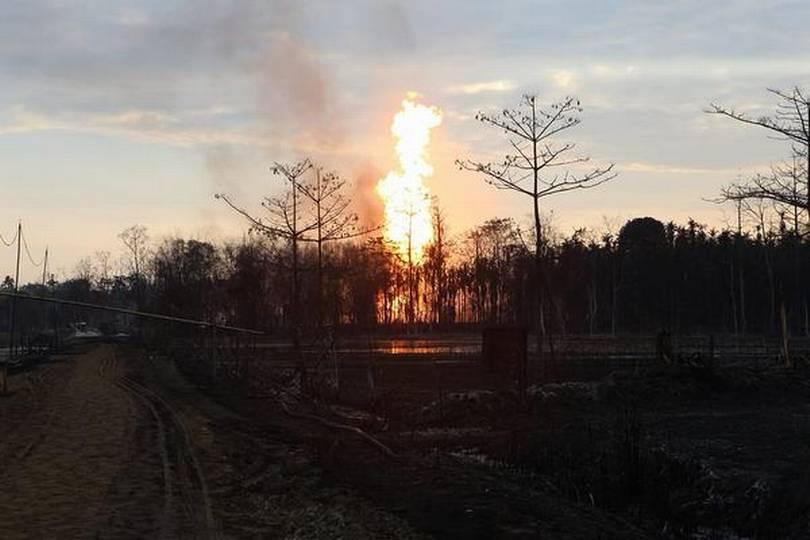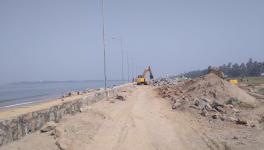Baghjan Oil Field Fire: A Prelude to Ecological Disaster in North East

Public sector Oil India Limited’s (OIL) natural gas well no.5 in its Baghjan oilfields in Assam’s Tinsukhia District in Eastern Assam, less than a kilometre from the ecologically rich and fragile Dibru-Saikhova National Park and Biosphere Reserve with several other ecological hotspots in close proximity, suffered a blowout, i.e. an uncontrolled release of natural gas, on May 27, 2020, throwing up huge quantities of gas at high pressure into the air.
On June 9, 2020, due to yet undetermined reasons, a fire erupted at the well and spread quickly over a distance of at least 5km toward the north-east. The fire has caused deaths of at least two firemen, and maybe others in nearby villages. Many nearby houses have been gutted and over 7,000 villagers have been evacuated to 12 relief camps.
The blowout and fire have caused extensive damage to human life, habitat and livelihoods, and to the surrounding ecosystem, especially crops, soil, water bodies and aquatic life, wildlife especially birds, and micro-organisms.
Experts from the Singapore-based Alert Disaster Control Company, called in by OIL to assist in controlling the blowout, arrived just a day before the fire erupted. Now, additional experts from the US and Canada have also been flown in. Heavy machinery and other equipment are being brought from OIL and ONGC facilities elsewhere in the region and from Andhra Pradesh. An action plan has apparently been prepared and operations are underway to control the fire and cap the well, expected to last about four weeks.
This still unfolding incident has once again focused attention on several inter-related aspects, namely, frequent industrial disasters and poor safety record of companies in India, continuing dangerous dismantling of environmental regulations by the Central government, leading to recurrent massive ecological damage along with loss of human lives, livelihoods and habitat.
Blowout and Fire
Baghjan 5 is one of the most prolific gas reservoirs of OIL. It produces gas from a depth of almost 4 km at a pressure of 4,200 pounds per square inch (PSI), much higher than the around 2,700 PSI.
Oil or gas blowouts are relatively rare in modern times, though not unknown, due to improved drilling techniques, better drilling fluids, and advances such as blowout preventers (BOP pronounced B-O-P not bop). BOPs are extremely heavy valves or similar mechanical devices which physically sit on the well mouth and prevent any venting of gas, oil or parts from the well, while also enabling pumping in of drilling fluids. Changes in pressure of gas or oil in a well causes ‘kicks’, which can be sensed by operators in many ways during drilling operations. If such ‘kicks’ are not controlled, ultimately through deployment of the BOP, then a blowout can result.
According to OIL, repairs of the well-head were taking place at Baghjan 5 on the fateful day. The well had been ‘killed,’ i.e. production had been stopped, and the BOP removed to enable the repairs. Simultaneously, ‘workover’ or test-drilling was underway at an adjacent new deposit. Suddenly, gas started oozing out of well no.5 and soon broke through the temporary barrier in a full-scale blowout.
Again, according to OIL spokespersons, the first response to the blowout, namely, capping the well by replacing the BOP under cover of a water umbrella even now poses a huge challenge and high risk because of “very limited space and non-availability of open space above the well head.” This points to a defective design of the well and rig set-up.
OIL will now have to deploy a heavy hydraulic transporter for capping the well, then pump in drilling mud, and provide for the water umbrella by building a special temporary reservoir in the nearby Dangori river and laying pipelines to the well. This further underlines poor standing arrangements for emergency situations.
Why and how the blowout happened in a killed well is being investigated by OIL, although two OIL employees at the site have been suspended for undisclosed reasons. The Assam government has ordered an Inquiry by a senior bureaucrat into the incident.
However, only an independent Inquiry by a committee of experts, free of pressures from the powerful public sector undertaking, OIL, the Central and State governments and regulatory authorities, preferably under judicial supervision, can properly bring out all the reasons behind the disaster and the responsibilities of various organisations and institutions involved.
Since OIL has numerous wells in the region, which contribute all of OIL’s crude oil and close to 90% of its natural gas, the lack of OIL emergency response teams and infrastructure within the region is a matter of grave concern.
OIL’s apparent and continuing lack of in-house expertise in oil/gas blowouts and similar emergencies despite over 100 years of operations in India, first as Burmah Oil, then in joint venture with OIL in 1961, and finally as a fully government-owned entity since 1981, as demonstrated in earlier blowouts in the region in 2004 and other accidents, is another matter of concern.
OIL needs to urgently address safety and emergency preparedness and response, especially in 18 other wells in the Baghjan oilfield and a total of 59 wells in Assam, where public anger and fear is at a peak after the poor and delayed response by OIL to the Baghjan disaster.
Damage to human life, livelihoods, habitat and health
The gas blowout spewed out a mix of propane, methane, propylene and other gases which spread over about 5km windward. For many days, villagers complained of eyes burning, headaches, gas condensate settling on crops, land and water bodies. While several villagers reported health complaints, there are to date no confirmed deaths among them.
Monitoring of health effects will obviously have to continue over an extended period of time. The families of two firemen, who apparently died by drowning while trying to escape from the fire, have been assured compensation by OIL, although follow-up is necessary.
Around 50 houses in the vicinity have been fully or partially burnt and a few thousand families are now sheltered in relief camps. Rehabilitation of all these families along with reconstruction of homes and compensation for damage incurred will obviously have to follow.
Many more people have also been badly affected by damage to their crops, land, livestock and livelihoods. Gas condensate and combustion residues carried by wind have been deposited on land, agricultural produce and water bodies. Land used for cultivation of areca nut, banana, tea and bamboo, may have suffered considerable damage even affecting future agriculture.
The Brahmaputra and several smaller rivers are in flood during the monsoons, and have brought condensate into farm lands, water bodies and even homes. The famous Maguri-Motapung Wetlands or beel, located inside the Dibru-Saikhowa Reserve and only 2km from Baghjan 5, has been badly affected, threatening food supply and livelihoods of almost all households around the beel. Considerable harm has thus been done to human livelihoods and habitat, and to the highly sensitive ecology of the area.
Ecological Damage
The entire region is home to many reserve forests, wildlife sanctuaries, protected water bodies, forests and other ecosystems. The Dibru-Saikhowa Biosphere Reserve in Assam links up with Namdapha National Park and Deomali Elephant Reserve in Arunachal Pradesh, together forming a large wildlife corridor in the Indo-Myanmar Biodiversity Hotspot.
The Maguri-Motapung Wetlands, rich in aquatic flora and fauna, including the endangered Gangetic Dolphin, at least one of which has been found dead, has been badly affected. Waters in the wetland have reportedly turned blue and yellow due to contamination. The Reserve and wetland are famous for their resident as well as migratory birds, butterflies, wild cats and feral horses.
Since the Reserve is close to the confluence of the Brahmaputra and other rivers of the North-East, such as the Lohit, Dibru, Dibang and Siang, contamination from condensate and combustion residues is likely to spread widely through these rivers. Substantial parts of this ecosystem may even have suffered permanent impairment. Damage to wildlife, bio-diversity, water bodies and the broader ecosystem in the area requires systematic and careful assessment towards remedial action.
The management plan for the beel highlights oil leaks as a potential hazard to the ecosystem and, having seen the damage from a gas blowout, one can imagine the impact of a blowout at any of the oil wells in the area which would be far greater. The National Board for Wildlife (NBW) during earlier inspections in the area had warned against further expansion of oil drilling activities in this region.
Reckless Environmental Clearances
Ironically, the same NBW, on April 24, 2020, permitted use of part of the nearby Dehing-Patkai Elephant Reserve for opencastcoal miningby North-Eastern Coal Fields (NECF), a subsidiary of Coal India Limited, and a much wider area for underground coal mining. This underlines a sharply increasing trend encouraged by the Central government to indiscriminately allow extractive industries and infrastructure projects in forests, sanctuaries and protected areas, and to dilute rules and regulations to enable the same.
The Ministry of Environment & Climate Change (MoEFCC) gave Environmental Clearance as recently as May 11, 2020 for exploratory drilling by OIL for hydrocarbons in seven locations in the Dibru-Saikhowa National Park, allegedly without careful scrutiny by experts.
OIL justified this by saying it would “not enter the National Park” but use Extended Reach Drilling (ERD) from a plinth 1.5km outside the Park boundary at a pre-existing well head but reaching into a new well drilled 3.5km under the surface of the Park. Such extensive exploration and subsequently extraction of oil and/or gas further threatens the sensitive ecosystem of this area and exposes the region to much higher risks of accidents.
Whether the actual well mouth is inside or just outside the Park, matters little if a blowout or leak occurs. At Baghjan, for instance, gas from the blowout and the resultant fire spread over several kilometers of the Park and wetland, and affected many water bodies and ecosystems due to condensate being carried in the wind and entering river systems.
The hasty and blanket clearances given by MoEFCC, without rigorous environmental assessment by experts also emboldens project holders, especially large and powerful PSUs and corporate houses, to ignore environmental considerations, abandon precautionary measures, and turn a deaf ear to public concerns and protests. The Draft Environmental Impact Notification 2020 proposes to regularise such blanket clearances for exploration.
To add fuel to the fire, the Directorate General of Hydrocarbons (DGH) announced an Open Acreage Licensing Policy (OALP) in August 2017 which essentially allows private entities to apply for exploration in sites of their choosing. Bidders are required to have only one year’s experience in exploration and related activities, opening the door to inexperienced and unqualified companies merely chasing profits at the cost of the environment and local populations. If even large 100 year-old companies like OIL find it difficult, or do not care, to take adequate safety precautions, one shudders to think what may happen if rank novices enter this sector.
Need for Independent inquiry
As always happens, many inquiries are underway, by OIL, Assam government, police, district administration and so on. However, given the power and influence of the oil and gas PSU major, the strong vested interest of the Assam government in OIL’s continued activities in the state, and the active collusion of environmental regulatory authorities in the state as well as the Centre, especially the MoEFCC, only an independent inquiry committee of experts under judicial supervision can bring about the required results.
In broad terms, such an inquiry should ascertain the full facts about this incident, make a comprehensive assessment of the ecological damage caused, recommend remedial action required for restoration of the ecology of the region and related costs to be borne by OIL, and suggest measures to reverse the reckless environmental clearances being given by the MoEFCC for fossil fuel exploration and extraction at least in this part of the North East.
More specifically, about the blowout itself, the probe should look into the design and layout of OIL Baghjan well no.5 and related infrastructure, safety measures and emergency preparedness at the site and in the Baghjan oilfields in general, operational errors and capabilities of OIL personnel on the spot at the time of the blowout, and whether any early warning indications were detected and measures if any taken to prevent the blowout.
The possible contribution to the blowout by the adjacent workover in a new ‘sand’ outsourced by OIL to John Energy of Gujarat also needs investigation. Compensation and relief and rehabilitation measures also need to be determined. Finally, a safety audit should be conducted, particularly for emergency preparedness and response, of all other OIL wells in the Baghjan oilfield and other sites in the North East.
Get the latest reports & analysis with people's perspective on Protests, movements & deep analytical videos, discussions of the current affairs in your Telegram app. Subscribe to NewsClick's Telegram channel & get Real-Time updates on stories, as they get published on our website.
























